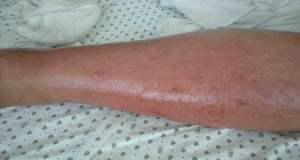What's in this article?
What is cellulitis?
Cellulitis is a bacterial infection of the skin and tissues beneath the skin. Unlike impetigo, which is a very superficial skin infection, cellulitis is an infection that also involves the skin’s deeper layers: the dermis and subcutaneous tissue. The main bacteria responsible for cellulitis are Streptococcus and Staphylococcus (“staph”), the same bacteria that can cause impetigo. MRSA (methicillin-resistant Staph aureus) can also cause cellulitis. Sometimes, other bacteria (for example, Hemophilus influenzae, Pneumococcus, and Clostridium species) may cause cellulitis as well.
Cellulitis is fairly common and affects people of all races and ages. Men and women appear to be equally affected. Although cellulitis can occur in people of any age, it is most common in middle-aged and elderly people.
Cellulitis facts
♦ Cellulitis is a spreading bacterial infection of the skin and tissues beneath the skin.
♦ Staphylococcus and Streptococcus are the types of bacteria that are usually responsible for cellulitis, although many types of bacteria can cause the condition.
♦ Sometimes cellulitis appears in areas where the skin has broken open, such as the skin near ulcers or surgical wounds.
♦ Cellulitis is not contagious.
♦ Cellulitis is treated with oral or intravenous antibiotics.
What causes cellulitis?
Cellulitis is caused by bacteria, most often strep or staph. You can get infected after any event that causes a break in the skin, such as:
♦ Surgery.
♦ A cut or bite.
♦ A new tattoo or piercing.
♦ Problems that cause skin breakdown, such as eczema, psoriasis, or a fungal infection like athlete’s foot.
Sometimes cellulitis can occur even if there wasn’t an obvious break in the skin.
Cellulitis symptoms
Cellulitis usually begins as a small area of tenderness, swelling, and redness that spreads to adjacent skin. As this red area begins to enlarge, the affected person may develop a fever, sometimes with chills and sweats, tenderness, and swollen lymph nodes (“swollen glands”) near the area of infected skin.
Possible signs and symptoms of cellulitis include:
♦ Redness
♦ Swelling
♦ Tenderness
♦ Pain
♦ Warmth
♦ Fever
The changes in your skin may be accompanied by a fever. Over time, the area of redness tends to expand. Small red spots may appear on top of the reddened skin, and less commonly, small blisters may form and burst.
Symptoms such as drowsiness, lethargy, blistering, and red streaks could signal that cellulitis is spreading. If any of these symptoms occur, you should contact your doctor immediately.
How Cellulitis diagnosed?
Doctors are often able to diagnose cellulitis based on your symptoms and a physical exam. In most cases, you won’t need further testing.
But tests sometimes may be done to find out what’s causing your symptoms and to rule out other problems. For example, you may need blood tests, an ultrasound, or an imaging test such as a CT scan or an MRI.
This exam might reveal:
♦ swelling of the skin
♦ redness and warmth of the affected area
♦ drainage (if there is an infection)
♦ swollen glands
Depending on the severity of your symptoms, your doctor may want to monitor the affected area for a few days to see if redness or swelling spread. In some cases, your doctor may perform a blood test or a culture of the wound to test for the presence of bacteria.
Antibiotics for Cellulitis
Cellulitis is treated with antibiotics. If the infection is mild, you may be able to take antibiotic pills at home.
Treatment for uncomplicated cellulitis is usually for 10 to 14 days but antibiotics should be continued until all signs of infection have cleared (redness, pain and swelling) sometimes for several months. Oral antibiotics used commonly are penicillin, flucloxacillin, dicloxacillin, cefuroxime or erythromycin.
If the infection is severe, you may need to be treated in a hospital so that you can get IV antibiotics directly into your bloodstream, along with any other care you may need.
Be sure to follow your doctor’s instructions about medicine and skin care. To help with your recovery and to feel better:
♦ Take all of your medicine as prescribed. Don’t stop taking it just because you feel better. You need to take the full course of antibiotics.
♦ Elevate the affected area to reduce swelling. Warm compresses may also help.
♦ Use pain relievers as needed.
Cellulitis should go away within seven to 10 days of starting antibiotics. Longer treatment could be necessary if your infection is severe. This can occur if you suffer from a chronic disease or if your immune system is not working properly. People with certain pre-existing medical conditions and risk factors may need to stay in the hospital for observation during treatment. Your doctor may advise hospitalization if you:
♦ have high temperature
♦ have high blood pressure
♦ have an infection that does not improve with antibiotics
♦ have a compromised immune system due to other diseases
♦ require intravenous antibiotics when oral antibiotics do not work





